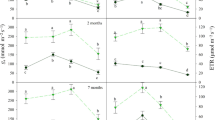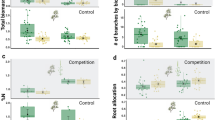Abstract
Seeds (nutlets) of four temperate-zone perennialCarex species from various habitats and with different growth forms were investigated to identify seasonal germination patterns. In the first experiment, freshly matured seeds were sown in summer 1994 on the soil surface and at a depth of 1 cm at a sunexposed site and under a leaf canopy in an experimental garden. In the second experiment, seeds were exhumed after various periods of burial (7-cm depth) for up to 30 months and tested for germination in both light and darkness at 15°, 25°, and 22/10°C. In the first experiment, freshly-matured seeds of the four sedges did not germinate during summer or autumn 1994. Almost all surface-sown seeds of the four species germinated from late spring to summer in 1995 at the sun-exposed site. Most buried seeds of three species germinated in the soil, but germinants died prior to emergence. InCarex flacca, however, about 50% of the buried seeds germinated and emerged until 1997, and the ungerminated seeds remained viable. At the shaded site, seeds ofC. acutiformis. andC. flacca did not germinate, whereas a small percentage of the buried and surface-sown seeds ofC. arenaria andC. extensa emerged in the second year. Seeds ofC. acutiformis andC. flacca were dormant, and those ofC. arenaria andC. extensa were conditionally dormant at the beginning of the second experiment. All four species had annual dormancy cycles at 22/10°C in light and in darkness and at 25° and 15° in light. Seeds came out of dormancy in late autumn or winter and re-entered dormancy or conditional dormancy in late spring or early summer. Very few seeds of any of the four species germinated at constant temperatures in darkness. No seeds germinated during burial in soil at a depth of 7 cm. These field germination patterns indicate that the four sedges have the potential to form a persistent seed bank but that losses due to germination in the seed bank are dependent on temperature amplitudes, mean temperatures, and red: far red ratios under a leaf canopy.
Similar content being viewed by others
Literature Cited
Baskin, C. C. and J. M. Baskin. 1988. Germination ecophysiology of herbaceous plant species in a temperate region. American Journal of Botany 75:286–305.
Baskin, C. C., J. M. Baskin, and E. W. Chester. 1993a. Seed germination ecophysiology of four summer annual mudflat species of Cyperaccac. Aquatic Botany 45:41–52.
Baskin, C. C., J. M. Baskin, and E. W. Chester. 1993b. Germination ecology ofLeptochloa panicoides, a summer annual grass of seasonally dewetered mudflats. Acta Oecologia 14:693–704.
Baskin, C. C., J. M. Baskin, and E. W. Chester. 1994. Annual dormancy cycle and influence of flooding in buried seeds of mudflat populations of the summer annualLeucospora multifida. Ecoscience 1:47–53.
Baskin, C. C., J. M. Baskin, and E. W. Chester. 1996b. Seed germination ecology of the aquatic winter annualHottonia inflata. Aquatic Botany 54:51–57.
Baskin, C. C., J. M. Baskin, and D. M. Spooner. 1989. Role of temperature, light and date: seeds were exhumed from soil on germination of four wetland perennials. Aquatic Botany 35:387–394.
Baskin, C. C., E. W. Chester, and J. M. Baskin. 1996a. Effect of flooding on annual dormancy cycles in buried seeds of two wetlandCarex species. Wetlands 16:84–88.
Baskin, J. M. and C. C. Baskin. 1981. Seasonal changes in germination responses of buried seeds ofVerbascum thapsus andV. blattaria and ecological implications. Canadian Journal of Botany 59:1769–1775.
Baskin, J. M. and C. C. Baskin. 1985a. The annual dormancy cycle in baried weed seeds: A continuum. BioScience 35:492–498.
Baskin, J. M. and C. C. Baskin. 1985b. Does seed dormancy play a role in the germination ecology ofRumex crispus? Weed Science 33:340–343.
Baskin, J. M. and C. C. Baskin. 1990. Role of temperature and light in the germination ecology of buried seeds ofPotentilla recta. Annals of Applied Biology 117:611–616.
Baskin, J. M. and C. C. Baskin. 1980. Ecophysiology of secondary dormancy in seeds ofAmbrosia artemisiifolia. Ecology 61:475–480.
Baskin, J. M., C. C. Baskin, and J. F. McCormick. 1987. Seasonal changes in in germination responses of buried seeds ofPortulaca smallii. Bulletin of the Torrey Botanical Club 114:169–172.
Bouwmeester, H. J. and C. M. Karssen. 1993. Annual changes in dormancy and germination in seeds ofSysimbrium officinale. Plant Physiology 124:179–191.
Courtney, A. D. 1968. Seed dormancy and field emergence inPolygonum aviculare. Journal of Applied Ecology 5:675–684.
Eriksson, O. 1989. Seedling dynamics and life histories in clonal plants. Oikos 55:231–238.
Grime, J. P., G. Mason, A. V. Curtis, J. Rodman, S. R. Band, M. A. G. Mowforth A. M. Neal, and S. Shaw. 1981. A comparative study of germination characteristics in a local flora. Journal of Ecology 69:1017–1059.
Gutterman, Y. 1993. Seed Germination in Desert Plants. Springer Verlag, Berlin, Germany.
Hegi, G. 1980. Illustrierte Flora von Mitteleuropa. Vol. 2(1) 3d edition, Parey Verlag, Berlin-München, Germany.
Jermy, A. C. and T. G. Tutin. 1968. Sedges of the British Isles. Botanical Society of the British Isles, London, UK.
Kinzel, W. 1915. Frost und Licht als beeinflussende Kräfte bei der Samenkeimung—Erläuterungen und Ergänzungen zum ersten Buche. Ulmer Verlag, Stuttgart, Germany.
Lauer, E. 1953. über die Keimtemperatur von Ackerunkräutern und deren Einfluß auf die Zusammensetzung von Unkrautgesellschaften. Flora 140:551–595.
Maas, D. and A. Schopp-Guth. 1995. Seed banks in fen areas and their potential use in restoration ecology. p. 189–206.In B. D. Wheeler, S. C. Shaw, W. J. Fojt, and R. A. Robertson (eds.) Restoration of Temperate Wetlands. John Wiley and Sons. New York, NY, USA.
Masuda, M. and I. Washitani. 1990. A comparative ecology of the seasonal schedules for “reproduction by seeds” in a moist tall grassland community. Functional Ecology 4:169–182.
Meyer, S. E. and S. G. Kitchen. 1992. Cyclic seed dormancy in the short-lived perennialPenstemon palmeri. Journal of Ecology 80: 115–122.
Milberg, P. 1994a. Annual dark dormancy cycle in buried seeds ofLychnis flos-cuculi. Annales Botanici Fennici 31:163–167.
Milberg, P. 1994b. Germination ecology of the polycarpic grassland poronnialsPrimula veris andTrollius europaeus. Ecography 17: 3–8.
Milberg, P. and L. Anderson. 1997. Seasonal variation in dormancy and light sensitivity in buried seeds of eight annual weed species. Canadian Journal of Botany 75:1998–2004.
Murdoch, A. J. and R. H. Ellis. 1992. Longevity, viability and dormancy. p. 193–229.In M. Fenner (ed.) Seeds—The Ecology of Regeneration in Plant Communities. CAB International, Wallingford, UK.
Olff, H., D. M. Pegtel, J. M. van Groenendael, and J. P. Bakker. 1994. Germination strategies during grassland succession. Journal of Ecology 82:69–77.
Pons, T. L. 1991a. Induction of dark dormancy in seeds: its’ importance for the seed bank in the soil. Functional Ecology 5:669–675.
Pons, T. L. 1991b. Dormancy, germination and mortality of seeds in a chalk-grassland flora. Journal of Ecology 79:765–780.
Pons, T. L. 1992. Seed responses to light. p. 259–284.In M. Fenner (ed.) Seeds—The Ecology of Regeneration in Plant Communities. CAB International, Wallingford, UK.
Poschlod, P. and S. Jordan. 1992. Wiederbesiedlung eines aufgeforsteten Kalkmagerrasenstandortes nach Rodung. Zeitschrift für ökologic und Naturschutz 1:119–139.
Probert, R. J. 1992. The role of temperature in germination ecophysiology. p. 285–326.In M. Fenner (ed.) Seeds—The Ecology of Regeneration in Plant Communities. CAB International, Wallingford, UK.
Roberts, H. A. 1986. Seed persistence in soil and seasonal emergence in plant species from different habitats. Journal of Applied Ecology 23:639–656.
Schütz, W. 1995. Keimungsökologie von 5 horstbildendenCarex-Arten nasser Standorte. Verhandlungen der Gesellschaft für ökologie 24:155–160.
Schütz, W. 1997a. Are germination strategies important for the ability of cespitose wetland sedges (Carex) to grow in forests? Canadian. Journal of Botany 75:1692–1699.
Schütz, W. 1997b. Primary dormancy and annual dormancy cycles in seeds of six temperate wetland sedges. Aquatic Botany 59:75–85.
Schütz, W. 1998. Germination responses of temperateCarex-species to diurnatly fluctuating temperatures—a comparative study. Flora, in press.
Thompson, K. and J. P. Grime. 1983. A comparative study of germination responses to diurnally fluctuating temperatures. Journal of Applied Ecology 20:141–156.
Thompson, K. and K. Baster. 1992. Establishment from seed of selected Umbelliferae in unmanaged grassland. Functional Ecology 6:346–352.
Thompson, K., S. H. Hillier, J. P. Grime, C. C. Bossard, and S. R. Band. 1996. A functional analysis of a limestone grassland community. Journal of Vegetation Science 7:371–380.
Van Assche, J. A. and K. A. Vanlerberghe. 1989. The role of temperature on the dormancy cycle of seeds ofRumex obtusifolius L. Functional Ecology 3:107–115.
Vleeshouwers, L. 1977. Modelling weed emergence patterns. Ph.D. Dissertation. Wageningen Agricultural University. Wageningen, The Netherlands.
Walter, H and S. W. Breckle. 1986. ökologie der Erde—Spezielle ökologie der Gemäßigten und Arktischen Zonen Euro-Nordasiens, Band 3. Fischer, Stuttgart, Germany.
Washitani, I. and M. Masuda. 1990. A comparative study of the germination characteristics of seeds from a moist tall grassland community. Functional Ecology 4:543–557.
Author information
Authors and Affiliations
Corresponding author
Rights and permissions
About this article
Cite this article
Schütz, W. Seed dormancy cycles and germination phenologies in sedges (Carex) from various habitats. Wetlands 18, 288–297 (1998). https://doi.org/10.1007/BF03161664
Received:
Revised:
Accepted:
Issue Date:
DOI: https://doi.org/10.1007/BF03161664




